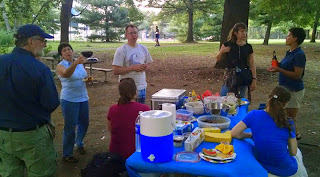| Ever seen a perched Chimney Swift? Probably not. (Photo by G. Armistead) |
Birders keeping track of their bird list for the year often refer to these sightings. FOY = First of the year. FOS = First of the season. I just had my FOS Broad-winged Hawk today at Heinz National Wildlife Refuge. I'm not really doing a big year but am keeping track of what I see in Philly this year and I had my FOY Little Blue Heron at Heinz NWR two days ago.
As birders we're pretty good at noting new arrivals. They're fun. All of a sudden something is present that wasn't there before. We're a lot less good at noticing when something isn't around anymore. When's the last Orchard Oriole you saw? If you've been birding regularly this year it's probably been close to a month since you last saw one. They're gone (until ~late April).
For me one of the big events each year is the arrival of Chimney Swifts in spring. It's the same every year. It's late April and I'm walking somewhere in Center City and I hear that familiar twittering call and then I know; spring really has arrived. And when they're gone winter is practically upon us. But when are they gone?
I'd like to issue a challenge. Let's see who will find the "LOY" Chimney Swift; the last-of-the-year Chimney Swift. The Chimney Swift Challenge we can call it. Try seeing Chimney Swift as late as you can. Let's see who sees the last one. I think of them as being gone in mid-October, but if you look at the eBird data (below) you'll see there are actually a few November sightings for Philadelphia. But their numbers here are thinning as we speak, as they head for points south in South America.
If you're interested in learning more about arrival dates, late dates, and high counts of species in Philadelphia, check out this eBird link. Lots of cool information to peruse there. In the meantime, keep after those Chimney Swifts and let's see how long they stick around this year. Fall will be over before you know it.
 |
| The ol' "Flying Cigar", a migration champ, the Chimney Swift. |







